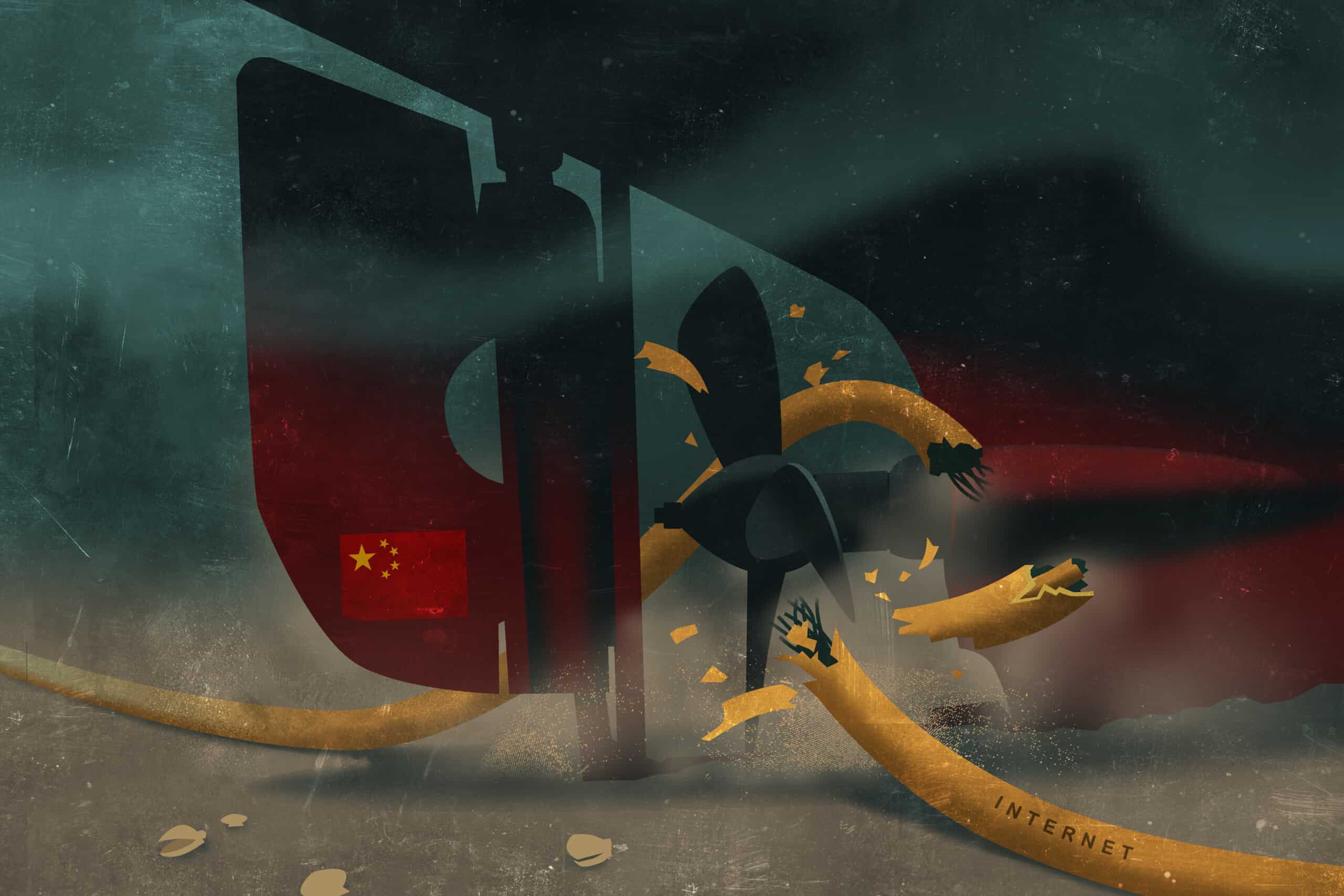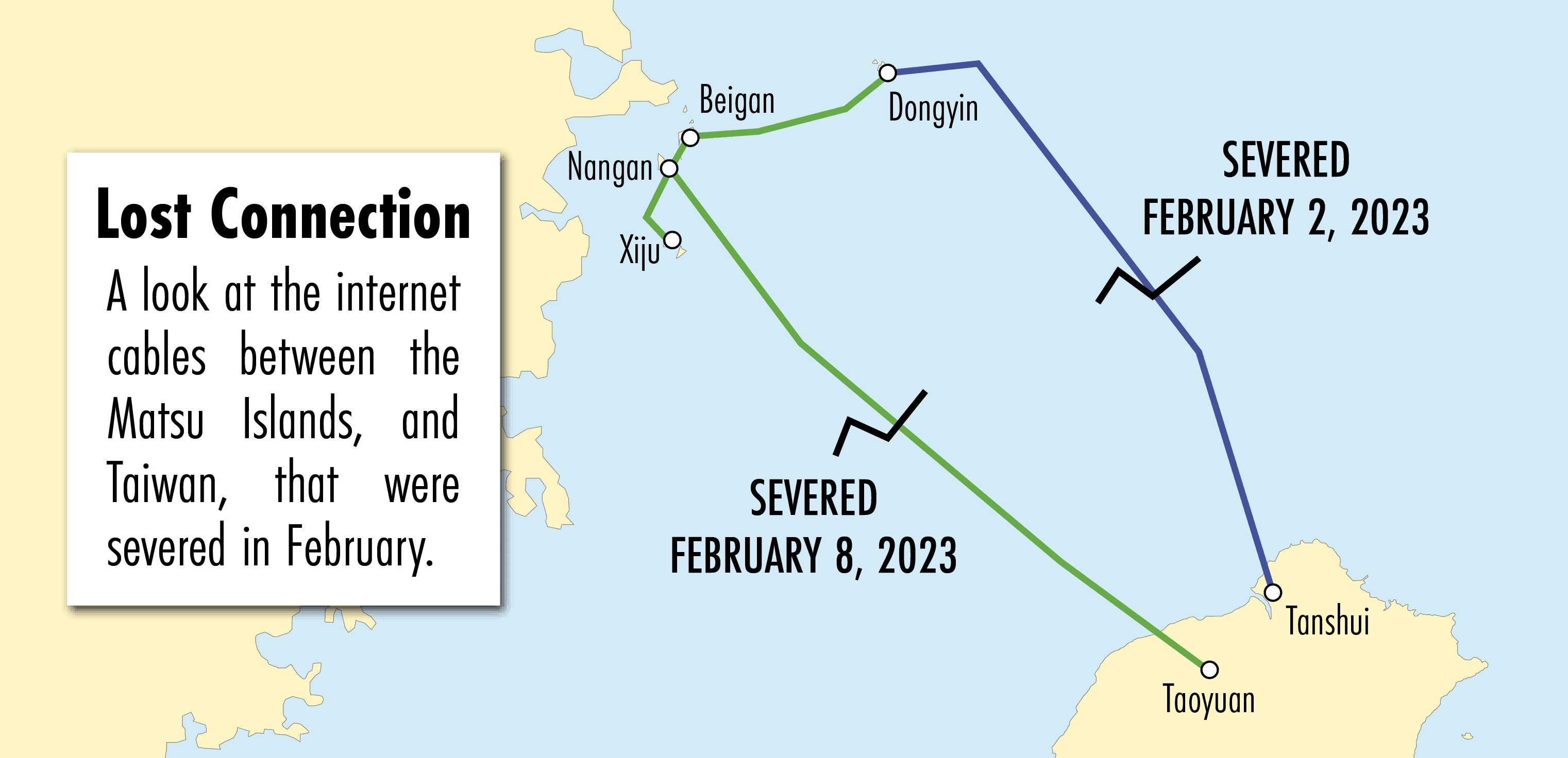
MATSU, TAIWAN – In February and March of this year, when the mayor of Nangan township, Lin Zhidong, wanted to check his email, it meant walking 15 minutes across the rolling hillside from his office to a crowded phone company outpost where he could connect to a WiFi hotspot and wait for his messages to load.
This was far from the normal state of being for the people of the Matsu islands, which — while a 3 hour ferry ride from Taipei — is part of Taiwan and home to a vibrant tourism industry. But access to the internet for Lin and 14,000 other Matsu residents started to deteriorate on February 2, when a Chinese fishing vessel severed the first of two subsea cables connecting the islands to mainland Taiwan. Then, six days later, an unidentified cargo ship severed the second cable, the only other link to the Taiwanese mainland.

The chain of 36 islands and islets, which is slightly more than five miles away from the People’s Republic of China at its closest point, would have been completely cut off from the outside world were it not for a backup microwave transmitter. With limited bandwidth reserved for critical services like hospitals, the local telecom company established WiFi hotspots outside its branches, but funneling all of the internet traffic through a single choke point meant achingly slow speeds of connection. And if using mobile data elsewhere, Matsu’s residents could forget about browsing photos on Instagram or communicating on LINE, a social app that is widely-used for messaging and payments — let alone data heavy tasks like watching a video on Netflix. Sending a single text message could take as long as 20 minutes.
“We’re all afraid of losing internet access again,” Lin says. “The impact on our lives was huge.”
Internet service to Matsu was restored on March 31 when Taiwan’s government hired a cable repair ship. It wasn’t the first time the Taiwanese government had to step in, and it likely won’t be the last time, either. According to data obtained by Lii Wen, director of the Matsu Islands office for Taiwan’s Democratic Progressive Party, the island chain has experienced 27 cable outages in the past five years, with the repair bill totaling $8.3 million so far.

At 51 days and with both lines cut, however, the latest outage was by far the longest and most disruptive.
All of Matsu’s cable problems have been attributed to man-made damage by sand dredgers, fishing trawlers or cargo ships — even though the locations of undersea cables are public knowledge to avoid such incidents — and the Taiwanese government has stopped short of calling the outages a deliberate act. But among defense experts and foreign policy analysts, the cause is clear: China.
Elisabeth Braw, a senior fellow at the American Enterprise Institute who researches emerging national security challenges and gray-zone threats, says the consistent pattern of cable cuttings indicates they are likely deliberate.
“If we look at the frequency with which the cables are damaged by Chinese vessels, it’s just far more frequent than the cables that connect other parts of the world,” she says.
Taiwan has seemed like an island under siege for some time: PLA warplanes regularly buzz its airspace and Chinese warships have disrupted maritime activity with days of military drills twice in the past year. Taiwan is also a constant target of cyber attacks and Chinese misinformation, seemingly intended to demoralize the population or influence its politics.
Many Taiwanese are inured to this kind of pressure. But the recent internet outage on Matsu was an illustration of how, with the right kind of disruption, normal life could suddenly grind to a halt. One of China’s goals in Taiwan, Braw says, is “to make the public lose their trust in the government’s ability to run the country.”
She also believes the recent outage on Matsu may have been a practice run — in preparation to cut off the whole of Taiwan from the internet — a fear that was echoed by other experts who warn of a new frontline in the global battle over information.
“The U.S. and China both understand that internet cables have replaced trains as the supply lines of modern warfare,” says Philippa Malmgren, a former special assistant to President George W. Bush for economic policy on the National Economic Council. “Everybody involved gets that cutting the internet cable is a highly effective hostile act. And everybody who isn’t involved has no idea it happened or why it matters.”
Indeed, the global battle for control of the internet is taking place largely out of sight — both in the Earth’s orbit and at the bottom of its oceans — and it has few precedents during peacetime. But Matsu’s outage fits into a pattern of similar internet outages recently in Europe, which some experts say were acts of deliberate vandalism by Russia.
Proving that, however, remains exceedingly difficult.

“Obtaining evidence for the cause of the subsea cable breakage is a significant challenge,” a spokesman for Taiwan’s National Communications Commission said in an emailed statement. “Therefore, whether it is related to Chinese ships remains speculation; as a result, the NCC has not concluded that the damage was intentional.”
The difficulty of obtaining evidence also limits potential criminal legal action against the operators of the vessels involved, the statement added.
U.S. policymakers were already discussing the risk of an adversary targeting submarine cables. The damaging of Matsu submarine cables in February accelerated these concerns…
Justin Sherman, a fellow at the Atlantic Council’s Cyber Statecraft Initiative.
Security experts say that subsea internet cables are a strong target for hostile governments because they are both fragile and vital. Over the years, the global telecommunications industry has developed processes to keep them safe, but as tensions with governments like China and Russia escalate, some worry it is not enough.
“U.S. policymakers were already discussing the risk of an adversary targeting submarine cables,” says Justin Sherman, a fellow at the Atlantic Council’s Cyber Statecraft Initiative. “The damaging of Matsu submarine cables in February accelerated these concerns, especially given how Congress and others are so worried about a possible Chinese invasion of Taiwan.”
‘JUGULARS OF THE WORLD ECONOMY’
The path of a viral cat video from a faraway server to your tablet screen is a much more physical process than might be apparent during the milliseconds it takes to load. Upon requesting a webpage, a device must first connect to a phone tower, WiFi network or a wired router, and then send a signal across thousands of miles of fiber optic cables, ferrying packets of information back and forth along the so-called internet backbone of principal data routes between major data centers.

While on land, these cables are easy to access for maintenance. But almost inevitably they reach an ocean, where they enter a cable landing station. These are critical national infrastructure — there are only 85 licensed submarine cable systems across the U.S., for example — and they are hardened to protect against damage from storms and carefully overseen by government regulators, like the Federal Communications Commission (FCC).
The underwater fiber optic cables are wrapped in steel to fend off shark bites and other accidental damage. They are also often buried as much as three meters underground, if the seabed allows for it, and their locations are public knowledge — precisely to prevent shipping traffic inadvertently cutting connections.

Still, human activity is the most common cause of cable outages, according to the International Cable Protection Committee, an organization based in Portsmouth, UK, which counts governments, telecoms companies, banks and even the U.S. Navy among its members. Every year, there are between 100 and 200 cases of damage to cables; of them, about half are caused by fishing trawler nets or dropped anchors, with the remainder the result of construction or other activity.
Natural disasters can also cause formidable damage to the cables. One earthquake off of the coast of Taiwan in 2006 saw submarine landslides near the intersection of two tectonic plates, causing nine cables to rupture. It took 11 ships almost two months to repair the damage. Tonga also lost internet access for a month last year after a volcanic eruption.
The fragility of submarine cables is not lost on policy makers. Governments have been trying to protect international telecoms since the Convention on the Protection of Submarine Cables, a treaty which was signed in Paris in 1884. Despite agreeing to work together, however, the strategic element of controlling international telecoms is irresistible, as Britain showed when it severed all but one of Germany’s submarine cables in August, 1914 — one of its first acts in World War I. The remaining cable was diverted to British control, which ultimately allowed London to intercept and decrypt the Zimmerman telegram, bringing the U.S. into the war in 1917. For her part, imperial Germany would send cruisers to attack British cable stations in the North Sea and as far afield as the Pacific and Indian oceans.

But while submarine cable outages are nothing new, they are becoming more common as the internet becomes more ubiquitous. And those outages are increasingly costly. In 2016, the U.K.’s Channel islands, an offshore finance jurisdiction, lost internet connectivity after a vessel dropped anchor in the wrong location, cutting three internet cables at once.
The next year, a report by future British prime minister Rishi Sunak called undersea cable infrastructure the “jugulars of the world economy.” And that same month, Mark Sedwill, the UK’s national security advisor, warned: “In the modern era you can achieve the same effect as used to be achieved in, say, World War II by bombing the London docks or taking out a power station by going after the physical infrastructure of cyberspace in the form of internet undersea cables.”
Cable outages are becoming more frequent across Europe, and when outages do occur, it’s not always clear what — or who — is to blame.
In November 2021, for instance, a marine observatory in Norway saw “extensive damage” to cables, according to the country’s Institute of Marine Research. Though its purpose is civilian, the observatory was capable of collecting vast amounts of data on ocean currents, passing aquatic life and nuclear submarines — the latter of which led some to speculate the damage was intentional.

A few months later, another Norwegian island archipelago in the Arctic circle, Svalbard, which is home to a station connecting several European and American satellite networks observing the Earth for scientific research, saw one of its two cables cut off after damage from an unknown source. The undersea cable connecting the Shetland islands to Scotland was also cut in October last year.
Each incident alone seems innocuous enough, but taken together, experts say they could represent repeated efforts to disrupt critical infrastructure.
“It’s happening a lot, but nobody puts it all together and looks at it as a worldwide pattern, or links it back to the plainly stated priorities of Russia and China of how they can look into and exploit these vulnerabilities,” says Keir Giles, a Russia expert at Chatham House. “Attacks like the ones on Norwegian infrastructure may not serve an immediate strategic aim — they can be no more than probing, or testing Russia’s own capabilities, and in particular the victim state’s responses.”
For its part, Russia’s priorities became clear after it annexed Crimea in 2014 and quickly took steps to replace Ukrainian internet services on the peninsula. Within days of taking control of the territory, Dmitry Medvedev, the Russian prime minister, directed the state communications company Rostelecom to build a new submarine cable directly from Russia — effectively exporting Moscow’s internet censorship.
It’s happening a lot, but nobody puts it all together and looks at it as a worldwide pattern, or links it back to the plainly stated priorities of Russia and China of how they can look into and exploit these vulnerabilities.
Keir Giles, a Russia expert at Chatham House
“We are now seeing Russian underwater activity in the vicinity of undersea cables that I don’t believe we have ever seen,” U.S. Navy Rear Adm. Andrew Lennon, the commander of NATO’s submarine forces, told The Washington Post in 2017. “Russia is clearly taking an interest in NATO and NATO nations’ undersea infrastructure.”
Such was the concern that in 2020 NATO reopened a command post in the north Atlantic which had been shuttered since 2003, in order to help patrol the sea lanes between Europe and America. But even if the cables remain intact, there are other risks. As the Atlantic Council’s Sherman puts it: “Cables are an espionage goldmine.”
Maintaining control over them, then, has also become a priority.
TEAM TELECOM, WORLD POLICE
For years, there were three big players in subsea cable construction: America’s SubCom LLC, which is owned by the private equity fund Cerberus Capital Management; Japan’s NEC Corporation; and Alcatel Submarine Networks, which is part of Finland’s Nokia Corp.
But disruption to the industry came in 2008 with the entry of Huawei Marine Networks — a subsidiary of Huawei Technologies, the Chinese telecom giant.

Huawei Marine Networks quickly became one of the world’s most active layers of undersea cables by undercutting its competitors on price. As of 2023, it had laid 44,300 miles of undersea internet cables, almost enough to circle the globe twice, and making it the fourth-biggest player in the industry.
Huawei Marine “has built or repaired almost a quarter of the world’s cables,” said FCC commissioner Geoff Starks in 2020. “This includes upgrades to a major submarine cable connecting the U.S. and Canada, as well as a cable connecting New York City and London.”

Starks also drew attention to Huawei Marine’s ongoing links to the Chinese government. When the U.S. Commerce Department blacklisted Huawei in 2019, deeming the parent company a national security risk, Huawei Marine Networks rebranded as HMN Technologies and spun off in 2020. (The Commerce Department blacklisted HMN the following year.) It is now majority owned by Hengtong Optic-Electric Co Ltd, a Shanghai-listed company with a market cap of about $5 billion. The company’s chairman is billionaire Cui Genliang, who served as a deputy to the 13th National People’s Congress last year.
According to a report from the Center for Strategic and International Studies in Washington, “Hengtong Group has won praise from the Chinese government for being a model of ‘civil-military integration,’ and a press release available only on the Chinese-language version of its website notes the company will ‘offer powerful support for the modernization of our country’s national defense’ and ‘advance into the international market.’”
HMN Technologies, Hengtong Optic-Electric, SubCom, NEC and Alcatel Submarine Networks did not respond to requests for comment.
Given the risks of a hostile government potentially laying and controlling its internet infrastructure, the U.S. has beefed up its regulatory oversight in the past few years. Since 1997, the FCC has referred to an informal group of cabinet-level advisors on national security matters as “Team Telecom.” But in 2020, as concerns about China mounted, then-President Trump signed an executive order granting new powers and responsibilities to the group, which became known formally as the Committee for the Assessment of Foreign Participation in the United States Telecommunications Services Sector.

According to one former Justice Department official who asked not to be named but was involved with the committee’s work, Team Telecom’s scrutiny of cable projects was inspired by two concerns: telecom operators’ “ability to collect data at scale,” and the fact that “if you’re in a position to collect data, you’re in a position to disrupt the flow of data and take down the ability to communicate.”
Team Telecom — which is separate from the FCC, chaired by the attorney general and composed of cabinet officials, including the secretary of defense and the secretary of homeland security — has since emerged as a leading protector of cable projects all over the world. It is often compared to the Committee on Foreign Investment in the United States (CFIUS), which has the power to block private acquisitions by foreign firms.
Indeed, Team Telecom’s reach extends far beyond the world of cable-laying ships — some of the biggest tech companies in the world have also felt its impact. As the volume of data being transmitted worldwide booms, internet giants like Meta Platforms (Facebook’s parent company), Alphabet (Google’s parent company), and Amazon are eager to get into the cable game. Big tech’s new investments in cable infrastructure are set to exceed 80 percent of spending on new submarine cables in the Atlantic Ocean during the next three years.

“These companies alone have such incredible demand for data center traffic that they’re driving projects and route prioritization for submarine cables,” says Alan Mauldin, a research director at TeleGeography. “This has been nothing short of revolutionary in an industry long-dominated by traditional internet carriers.”
But they still have to answer to Team Telecom. In 2020, for instance, following the imposition of Hong Kong’s draconian national security legislation, Team Telecom’s warnings about data security forced Google and Facebook to rethink new cables that would have landed in the city and would have represented the first direct link with the United States.
The committee also cited concerns about the relationship between China’s intelligence and security services and Dr. Peng Telecom & Media Group,1see The Wire China’s report on “Frayed Cable” and its mention of Dr. Peng Telecom here. which was a significant investor in the project and a major domestic provider of communications services. The license was ultimately granted in January last year but only after the Google and Facebook removed their Chinese partner and rerouted the 8,000 mile cable through Taiwan and the Philippines.
“What we worried about is no one was going to pay attention and Hong Kong was going to be the number one hub for data in Asia,” the former official says. “Everything was going to go through Hong Kong even if the sender and receiver had nothing to do with China.”
A similar fate befell efforts led by Facebook’s subsidiary Edge USA, Amazon subsidiary Vadata and China Mobile to establish a 9,600-mile link connecting California and Hong Kong. It was later resurrected with landing stations in the U.S. and the Philippines, but without involvement from China Mobile, which the FCC had already blocked from operating in the United States.
Team Telecom has also taken aim at projects that don’t directly connect Chinese and U.S. territory. Last year, it blocked cables from establishing landing stations in Cuba on national security grounds, in part because of the island’s relationship with Russia and China. Separately, a Singapore-to-France cable contract reportedly saw a bid from HMN that was a third cheaper than rivals, but the U.S. government successfully ran a campaign to flip the contract, according to Reuters. The contract was ultimately awarded to the U.S.’s SubCom.
Another planned bid by China’s HMN Technologies for a subsea cable project designed to improve communications between Nauru, Federated States of Micronesia and Kiribati floundered in 2021 after opposition from Washington, according to several press reports citing unnamed sources. The planned project would have connected to Guam, which is home to an American military base. The U.S., Australia and Japan later announced a new undersea cable to link the island nations.
The balancing act for Team Telecom, notes Sherman, at the Atlantic Council, “is to identify cases with substantial risks and act accordingly, but not to overreact and impede necessary global collaboration on the submarine cable network.”

Team Telecom’s influence, meanwhile, has not stopped Beijing’s efforts to compete with U.S.-led infrastructure projects. HMN Technologies is currently planning a 3,700 mile, $300 million cable line linking China and southeast Asia, due for completion in 2025. And earlier this year, Reuters reported that another China-led $500 million cable project is under discussion to link Hong Kong to the Middle East and Europe.
“It makes sense for China to try to control as much of the telecoms infrastructure as it can in peacetime, because then you don’t need to fight for it in wartime,” notes Giles, at Chatham House.
Taiwan also wants to prepare as much as possible in the event of war. With the outages on Matsu raising fears that China may seek to quietly damage or degrade Taiwan’s internet cables, Taiwan’s government has started awarding licenses to establish a network of satellites, which can provide a backup connection — much like Elon Musk’s Starlink did for Ukraine in the early days of the Russian invasion.
The whole [Matsu] incident sends a really strong warning signal to Taiwan. It reminds us that we must be better prepared for any kind of incident that could affect the stability of our telecommunications.
Lii Wen, from Taiwan’s Democratic Progressive Party.
This is hardly a cure-all, however. Only 3 percent of global internet activity currently happens via satellites, and the U.S. has warned that China is developing anti-satellite weaponry that can disable or destroy other networks. Still, as a small consolation for its recent troubles, the Matsu islands will be Taiwan’s first testing location for the satellites.
“The whole [Matsu] incident sends a really strong warning signal to Taiwan,” says Lii Wen, from Taiwan’s Democratic Progressive Party. “It reminds us that we must be better prepared for any kind of incident that could affect the stability of our telecommunications. If an internet outage can happen for Matsu so easily, a similar incident could happen to” all of Taiwan.

Gregor Stuart Hunter is a journalist based in Taipei. He has written for The Guardian, Nikkei Asia, Fortune, Bloomberg News and the Wall Street Journal, among others. @gregorhunter




